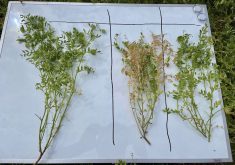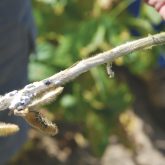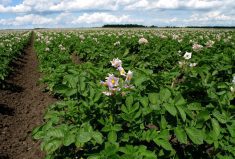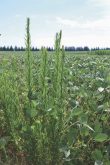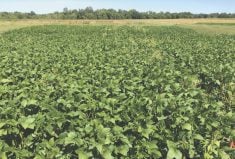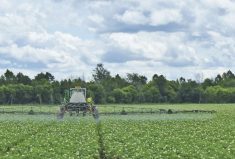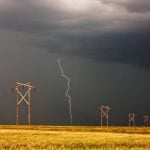As weeds and diseases continue to evolve and overcome the active ingredients and modes of action of different herbicides and fungicides, the chemical industry must evolve to keep pace. The research and development challenges are considerable — it can take more than 10 years to bring a new product to market, and cost nearly $300 million to develop one molecule from discovery to the point where it can be used in a producer’s field.
Much attention is focused on resistant biotypes in Canada fleabane and waterhemp in Eastern Canada, but disease issues like tar spot in corn and sudden death syndrome in soybeans are becoming more front-of-mind.
Country Guide offers industry stakeholders the opportunity to present short descriptions of their latest herbicide, fungicide and biological releases for 2022. While we strive to make this as comprehensive as possible, it’s just a starting point, which can be continued with a search of company websites or discussions with a company representative or a trusted advisor. The important thing is to garner more detail to make the best, most informed decision for your operation.
Read Also

Producers aren’t panicking over tariffs and trade threats
The influence of tariff and trade uncertainity on farm business decisions.
BASF
Herbicides
Smoulder is a Group 2 and Group 14 post-emergence burn-down for emerged weeds and residual pre-emerge control of secondary flushes of volunteer canola before seeding spring wheat or barley. When applied as a tank mix with glyphosate, it’s said to provide control of winter annual and perennial weeds. It also offers burn-down control of resistant broadleaf weeds including Groups 2-, 4- and 9-resistant biotypes of kochia. Other weeds on its label include Canada fleabane, dandelion, narrow-leaved hawk’s beard, lamb’s quarters and wild buckwheat. It is currently registered for Western Canada with plans to expand to Eastern Canada for 2023.
Voraxor provides enhanced pre-seed burn-down with residual suppression of broadleaf weeds at higher labelled rates in peas, lentils, corn, soybeans, wheat and barley. Its Group 14 active ingredient is Tirexor, which can be tank mixed with glyphosate for use in pre-seed, pre-emerge and chemfallow. Weeds listed on its label include kochia (15 cm), narrow-leaved hawk’s beard (8 cm), shepherd’s purse, cleavers, Canada fleabane and volunteer canola.
Fungicides
Sphaerex is a new and improved cereal head timing fungicide for management of late-season leaf diseases to protect grain quality and enhance yield in barley, oats, rye and wheat. It is rated as best-in-class in efficacy for improved quality management against fusarium head blight (FHB). Among the diseases on the label are powdery mildew and leaf rust in barley, rye, triticale and wheat and stagnospora leaf blotch in oats and wheat.
Veltyma was registered late last year as a broad-spectrum control against key leaf diseases on multiple crops including corn, wheat and potatoes. It contains the active ingredient Revysol, which BASF says is the first and only isopropanol-azole, with a Group 11 (pyraclostrobin) and Group 3 (mefentrifluconazole.) Its unique molecular structure binds target enzymes and provides best-in-class performance on a broad spectrum of diseases including some strains that have become resistant to other Group 3 fungicides.
Seed treatment
Vercoras is BASF’s latest seed treatment for canola, featuring an insecticide and four fungicide active ingredients for broad-spectrum protection against key seed- and soil-borne diseases such as blackleg and insects such as flea beetles. Company literature states it’s the first complete seed treatment designed to control airborne blackleg during the early-season infection period. It also reduces the potential for stem infection later in the season.

Bayer
Herbicides
Laudis is registered for use on field corn and sweet corn, providing excellent crop safety for control of annual broadleaf weeds. A Group 27 herbicide, it contains tembotrione, with the goal of managing herbicide-resistant weeds like Canada fleabane, ragweed and giant ragweed by adding another effective mode of action. Registered for Eastern Canada, Laudis will expand its commercial availability to Manitoba for the 2022 growing season, with kochia also on its label.
Fungicides
Delaro Complete adds a third mode of action to the Stratego Pro formula, delivering enhanced disease control in corn and soybeans. Fluopyram (Group 7) has been added to prothioconazole (Group 3) and trifloxystrobin (Group 11). In corn, it provides preventative defence against common rust, eye spot, northern corn leaf blight and tar spot. In soybeans, it protects against brown spot, phomopsis stem blight and frogeye leaf spot while suppressing white mould.
Prosaro Pro is a cereal fungicide registered for wheat and barley to protect it against fusarium head blight (FHB) including deoxynivalenol (DON) along with other leaf diseases. It also enters the market as the first foliar fungicide to suppress ergot, with powdery mildew, net blotch, scald, leaf blotch and leaf rust among the other diseases on its label. With the addition of fluopyram (Group 7) to its prothioconazole and tebuconazole Group 3 formulation, its literature bills it as the highest-yielding cereal fungicide.
Corteva
Herbicides
Exhilarate is primarily geared to Western Canada, with a focus on weeds affecting production of spring, durum and winter wheat as well as barley. A combination of Group 2 and Group 4 modes of action, it is billed as controlling a wide range of broadleaf weeds, including cleavers, hemp nettle, lamb’s quarters, narrow-leaved hawk’s beard and volunteer canola. It also has tank-mix flexibility, with options for Group 2 grass control of wild oats and Japanese brome in wheat. It can also be mixed with a Group 1 grass herbicide to control wild oats in wheat and barley.
Prominex is billed to deliver control of annual and perennial broadleaf weeds with the convenience of an all-in-one formulation. A Group 4 product for cereal production, its company literature states it controls kochia, cleavers, shepherd’s purse and volunteer canola, while suppressing dandelion and field horsetail among many others. Its convenient formulation allows for convenience and easy loading and its tank-mix flexibility allows for blending with Group 1 grass herbicide in wheat or barley and a Group 2 grass herbicide in wheat.
Biologicals
Utrisha N is a biological nutrient efficiency biostimulant billed to enhance plant growth and resilience by improving nitrogen availability in crops during the growing season. Through the use of the bacterium methylobacterium symbioticum, nitrogen from the air is converted from N2 to ammonium, resulting in a consistent supply of a usable form of nitrogen to the plant. In Eastern Canada, it’s registered for corn, soybeans and cereals with the addition of canola to the label for Western Canada.
NuFarm
Herbicides
TruSlate Pro is a cereal herbicide for use in spring cereals and winter wheat. It’s a combination of three active ingredients in one jug (MCPA, clopyralid and fluroxypyr) and is tank mixable with foliar fertilizers and fungicides. It has strong activity on weeds like Canada fleabane, vetch, cleavers, sow thistle and many other annual weeds and winter annual weeds. As with all of this company’s products, it will be made in North America and was expected to be registered before the beginning of the planting season.




